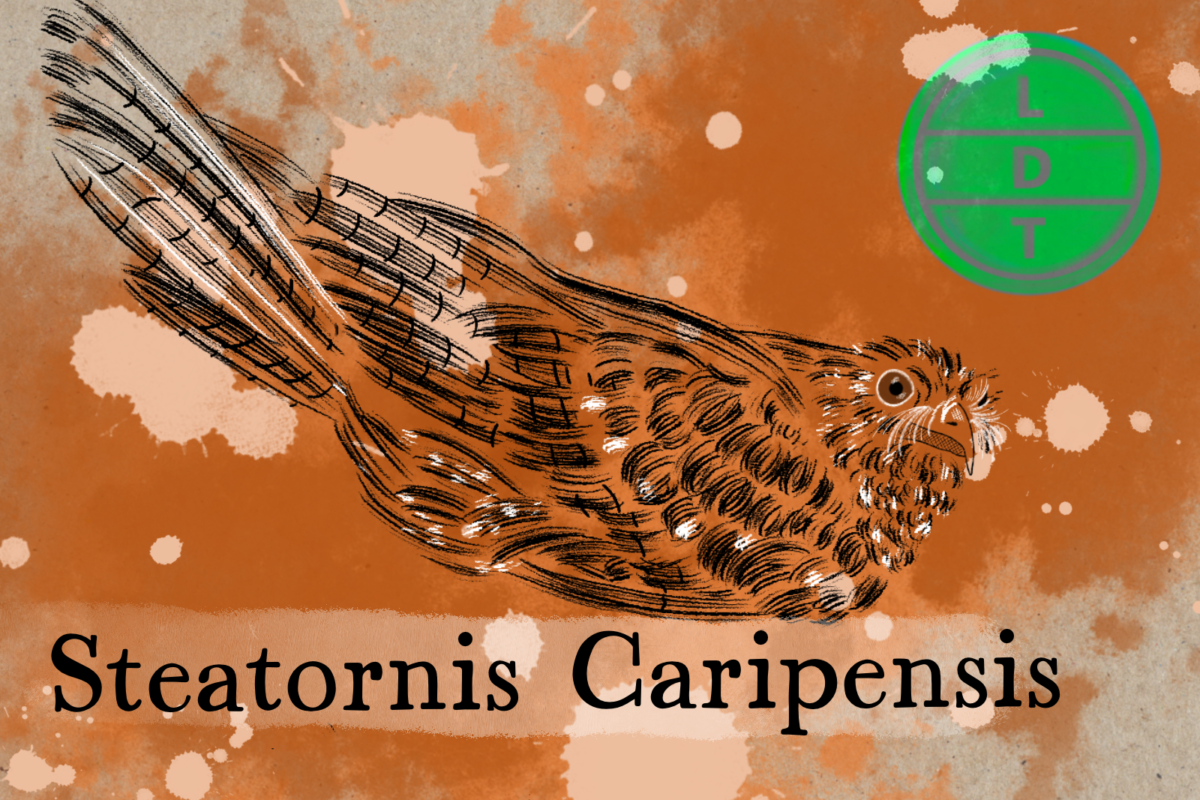“…and today we’re talking about a ba… I mean bird. But more on that later.”
The caves of the Caribbean are home to a slick bird that thinks it’s a bat. Deep in these midnight caverns, shining an unwelcome light will be met with the anguished screeches of the little devil known as the oilbird. But how does this bird navigate in the pitch black to find its favorite tasty fruit? Well it all comes down to having the right tools for the job here in Life, Death, and Taxonomy.
Description of the Oilbird
- Oilbirds are related and shaped like nightjars.
- They sit horizontally and often sit with their bellies on a surface, rather than upright.
- They have whiskers around their beaks called “rictal bristles.”
- Like many nightbirds, the oilbird has soft feathers to help them fly more quietly.
- Its head and wings are mainly reddish-brown with white spots.
- The lower part of the body is cinnamon with white diamond-shaped spots that start small towards the throat and get larger towards the back.
- Brown tail feathers are spotted with white on either side.
Measure Up
Welcome to the beloved Measure Up segment. The official listener’s favorite part of the show! The part of the show when we present the animal’s size and dimension in relatable terms through a quiz that’s fun for the whole family. It’s also the part of the show that’s introduced by you when you send in audio of yourself saying, singing, or chittering the words Measure Up into ldtaxonomy at gmail dot com. We do have a new Measure Up intro!
Length
- 40–49 cm (16–19 in)
- How many oilbirds go into the longest, fully stretched slinky?
- Hint: The slinky was made by Allen W. Jessee in 2017 for an exhibit on late 20th century toys.
- 63 oilbirds. The slinky was 50 to 100 feet. The slinky was four feet in diameter and 150 pounds.
Weight
- 350–475 g (12.3–16.8 oz)
- How many oilbirds go into the weight of the heaviest bardiche, a medieval polearm that is similar to a halberd with no spear or hook?
- Hint: The bardiche was used into the era of firearms. The bare top made it useful as a way to steady handguns.
- 8.5 oilbirds. Some bardiches were as heavy as 9 pounds.
Fast Facts about the Oilbird
Oilbirds come from South America and the caribbean.
Diet
Despite the fact that their relatives the nightjars are insectivores, oilbirds are fruit eaters and use specially adapted eyesight to forage for fruit at night. They particularly enjoy the fruit of the oil palm and tropical laurels.
Habitat
Not ones to rest on their laurels, they will retire to caves and live in colonies during the day. We once thought the birds never saw daylight because they only came out of caves at night. However, they also nest in cliffs and crags and spend many nights in trees.
Major Fact: Bird Echolocation
Oilbirds are unique in that they’re nocturnal frugivorous birds. In fact, they are the largest nocturnal frugivorous birds capable of flight. Which is pretty specific. Like I’m probably the only Carlos in Jacksonville that lets the milk soak in his cereal for a bit before eating. If I wanted to eat crunchy cereal, I’d eat it dry.
Because they live in caves and primarily come out at night, they often work in low-light conditions.
To help them, they have pretty incredible tools for a bird. For one, they have eyes that can gather more light than those of any other bird.Their large pupils compared to their eye size and the high density of rods they have in their retinas give them vision similar to deep-sea fish.
They actually have a million rods per square millimeter. Humans have about 150K, so over nine times worse than oilbirds. Cats are at about 350-400K. They have pretty low cone counts, so they don’t have great color or resolution.
But they can hunt by sound and not by sight.
The thing that makes oilbirds truly unique among their avian brethren is their ability to echolocate.
Like other animals that echolocate (like bats or dolphins), they can emit a series of mid-frequency clicks and listen for the echo to determine how close they are to trees, fruit, or cave walls.
Dolphins have more complex echolocation since they use their melons to focus, concentrate, and isolate sounds, allowing them to emit much higher frequencies and over larger distances.
The only other birds that use echolocation are a few species of swift and they don’t have enough oil or mustaches to be interesting.
Ending: So find a comfy cave, nestle in tight, and click your way to a better meal like the oilbird here in LDT.

